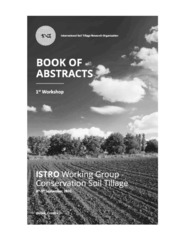Приказ основних података о документу
Effectiveness of soil tillage systems in maize weeds control
| dc.creator | Simić, Milena | |
| dc.creator | Dragičević, Vesna | |
| dc.creator | Brankov, Milan | |
| dc.creator | Kresović, Branka | |
| dc.creator | Dumanović, Zoran | |
| dc.date.accessioned | 2022-10-24T07:08:33Z | |
| dc.date.available | 2022-10-24T07:08:33Z | |
| dc.date.issued | 2020 | |
| dc.identifier.isbn | 978-953-7871-88-8 | |
| dc.identifier.uri | http://rik.mrizp.rs/handle/123456789/1017 | |
| dc.description.abstract | Reduced soil tillage is widely adopted since the awareness of agro-ecosystem and soil preservation and protection has become more important. Besides many advantages, this system of soil cultivation usually increases amounts of herbicides and multiplies its time of application. The aim of the experiment was to evaluate the influence of different tillage practices: T1 – no-till, T2 – reduced, and T3 - conventional tillage, as well as N fertilization rate: N1 – without fertilization; N2 – 180 kg N ha-1 , 50 kg P ha-1 , 50 kg K ha-1 ; N3–240 kg N ha-1 , 50 kg P ha-1, 50 kg K ha-1, on maize weed infestation and grain yield. Experiment was settled down 1978 while three years overview was done during 2017-2019. Maize hybrid (FAO 600) was sown in the density of 64.935 plants ha-1 . The broad-spectrum systemic herbicide glyphosate (2400 g ha-1 a.i.) was applied as necessary to control weed vegetation, prior to planting in the no-tillage treatment. After planting, the mixture of pre-emergence herbicides S-metolachlor + terbuthylazine at recommended rates (S-metolachlor 960 g ha-1 + terbuthylazine 120 g ha-1 a.i.), was applied in all treatments. Six weeks after herbicide application, weed biomass was evaluated. Maize grain yield was measured at the end of growing cycle and calculated at 14% of moisture. All data were process by ANOVA and differences were analyzed by LSD-test. Results showed that weed infestation was significantly higher in T1 than in T3. Soil tillage and level of fertilizers influenced weed fresh biomass which was significantly higher under no-tillage even with no fertilizer's application, 115.9 g m-2 . Maize grain yield in conventional tillage (8.27 t ha-1 ) was noticeable higher than in reduced (5.84 t ha-1) and no-tillage (3.14 t ha-1 ) indicating that, in agroecological conditions of Zemun Polje and slightly calcareous chernozem, conventional tillage is more convenient regarding weed control and maize productivity. | sr |
| dc.language.iso | en | sr |
| dc.publisher | Osijek : ISTRO – International soil tillage research organization | sr |
| dc.publisher | Osijek : CROSTRO – Croatian soil tillage research organization | sr |
| dc.rights | openAccess | sr |
| dc.rights.uri | https://creativecommons.org/licenses/by/4.0/ | |
| dc.source | 1. Workshop ISTRO working group "Conservation soil tillage", Osijek, 08-09.09.2020. - Book of abstracts | sr |
| dc.subject | soil tillage effectiveness | sr |
| dc.subject | nitrogen fertilization rate | sr |
| dc.subject | weeds control | sr |
| dc.title | Effectiveness of soil tillage systems in maize weeds control | sr |
| dc.type | conferenceObject | sr |
| dc.rights.license | BY | sr |
| dc.citation.spage | 17 | |
| dc.citation.epage | 17 | |
| dc.identifier.fulltext | http://rik.mrizp.rs/bitstream/id/4879/bitstream_4879.pdf | |
| dc.identifier.rcub | https://hdl.handle.net/21.15107/rcub_rik_1017 | |
| dc.type.version | publishedVersion | sr |


